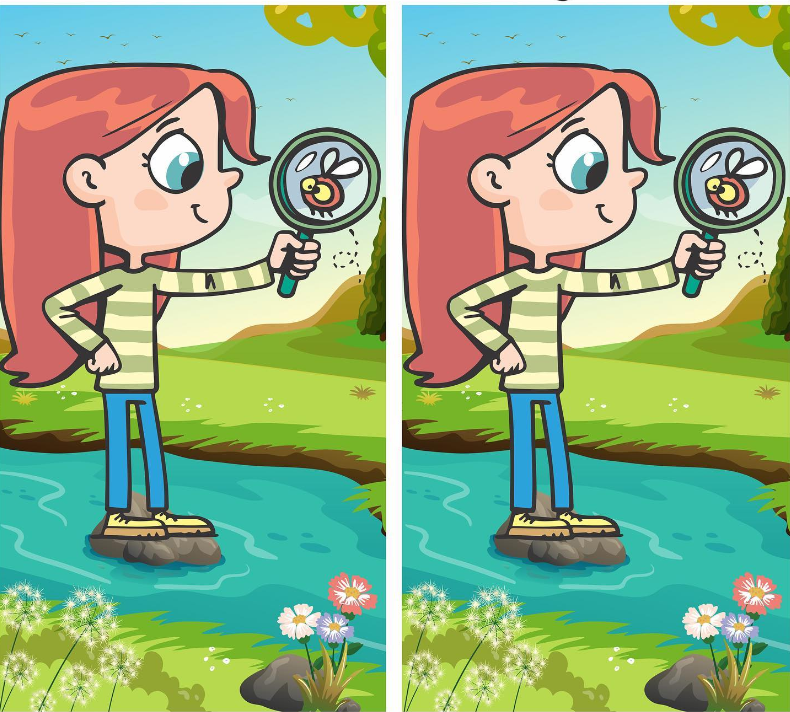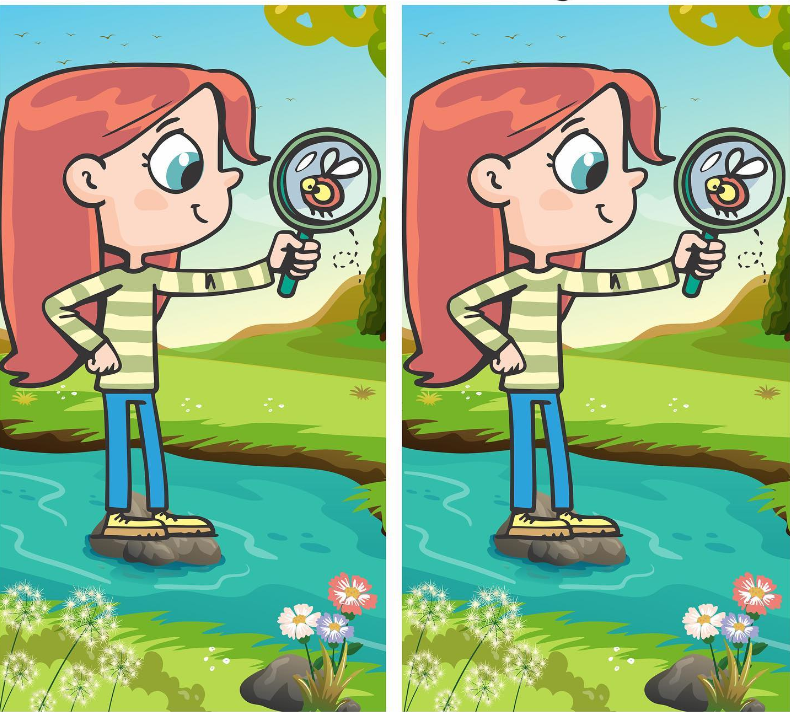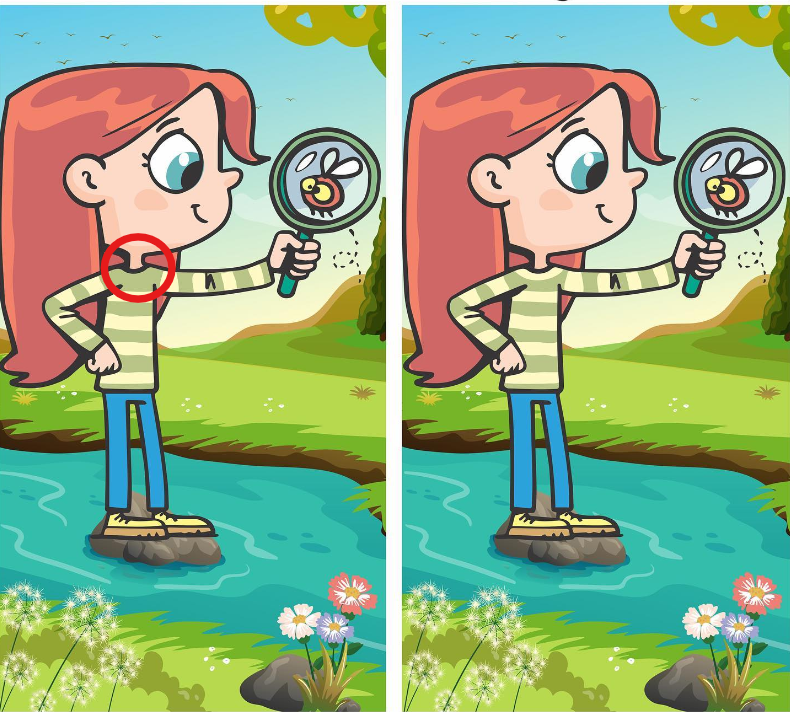Spot the Difference: Unraveling the Hidden Details in a Fascinating Scene
Are you ready for a fun visual adventure that will test your powers of observation? In this intriguing scene, a curious girl is holding a magnifying glass and focusing on a small fly, but there’s a twist! The image holds a subtle difference that makes this visual challenge even more exciting. Get ready to put your detective skills to the test as we explore this captivating landscape and discover the hidden details. Let’s dive in!

A Captivating Scene: The Girl and the Magnifying Glass
In this charming painting, we see a girl standing in a well-lit space, her attention fixed on a small fly through a magnifying glass. The light is concentrated on the magnifier, making the fly appear larger and clearer, inviting us into a world of curiosity and wonder. The girl’s eyes are wide with excitement as she explores this miniature world, fully immersed in the tiny creature under her lens. Her simple attire and neatly tied hair add a sense of innocence and curiosity to the scene.
This setting, while seemingly simple, holds a deeper narrative. The background suggests a cozy indoor environment, perhaps a desk near an open window, offering an airy and inviting atmosphere. It’s a perfect place for a young mind to dive into exploration, making the scene both enchanting and educational.
The Challenge: Spotting the Subtle Differences
The beauty of the “Spot the Difference” challenge lies in the small, yet impactful, changes between two seemingly identical images. In this case, it’s all about noticing the tiny details that set the two versions apart.
For instance, the magnifying glass itself can change in size or position. In one version, it might appear larger, with the fly’s details magnified more clearly, while in the other, the magnifying glass could shrink and obscure some of the fly’s features. Can you spot these changes?

The Fly: A Moving Target
The fly, the subject of the girl’s curiosity, is another area where differences might occur. In one version, the fly might be perfectly still, while in another, it could be fluttering slightly. Maybe one of its wings is missing, or perhaps it has an extra leg in one version, adding a level of complexity to the challenge. These little details make the task even more fun, as they encourage careful observation.
As you study the image, consider how even the smallest differences in the fly’s position or features can impact the overall look of the scene. The more you look, the more you’ll discover!
Changes in the Girl’s Expression and Hand Position
The girl’s hand and facial expressions can also differ from one version to the next. Perhaps in one version, she holds the magnifying glass in her left hand, while in the other, she uses her right hand. Her face might also show different emotions; in one version, she could be smiling with joy, while in another, her face could express surprise or even confusion. These small changes add personality to the character and help to create a more dynamic and engaging scene.
The Light: Reflective or Faint?
Another interesting element to focus on is the light shining on the magnifying glass. In one image, the light might be focused sharply on the glass, creating a strong reflection that highlights the fly’s details. In the other version, the light could be dimmer, with less focus on the magnifying glass, or it might not create a reflection at all. These subtle changes in lighting can make a significant difference in how the image feels, affecting the overall atmosphere.

Background Variations: A Change in the Environment
While the main focus is on the girl and the magnifying glass, don’t forget to examine the background. Small changes in the environment could also provide clues to the differences between the two versions. Maybe one version of the image has a window in a slightly different position, or perhaps there are items on the table in one version that are missing in the other. These slight alterations in the setting may seem insignificant at first, but they contribute to the overall uniqueness of the two images.
The Art of Observation: Why This Challenge is So Fun
This visual puzzle isn’t just a simple game—it’s a delightful exercise in attentiveness and focus. As you compare the two versions, you’ll notice how easy it is to overlook small details, yet how rewarding it is when you spot them. The more you practice, the sharper your eye for detail becomes. Plus, it’s a fun way to engage your brain and improve your observation skills!
Sharing the challenge with friends and family adds an extra layer of excitement. Who will spot the differences first? Can you beat your own record? The fun of the “Find the Difference” game is that it encourages healthy competition while allowing everyone to enjoy the process of discovery.
The Moment of Truth: Revealing the Hidden Difference
The time has finally come to reveal the difference between the two images. After carefully studying the details, comparing the girl’s hand, expression, the fly’s position, and the light effects, the moment of discovery is here. Whether you’ve found all the differences or just a few, you’ve sharpened your observational skills and enjoyed the thrill of the search.
And here it is—the hidden difference! Maybe the fly has moved, or the girl’s expression has changed, or perhaps the light effects were different. No matter how subtle, this difference highlights the fun and challenge of the game.

Conclusion: The Joy of Discovery
The “Spot the Difference” challenge is more than just a game—it’s a wonderful way to train your brain and engage with your surroundings in a new way. In this particular scene, the subtle changes between the two images create an interesting puzzle that keeps you on your toes. Whether it’s the fly’s movement, the girl’s hand position, or the background changes, each detail offers a unique twist to the story being told.
So, the next time you’re faced with a visual challenge, remember to take your time, look closely, and enjoy the journey of discovery. With each difference you uncover, you’ll gain a greater appreciation for the art of observation. Happy spotting!
















